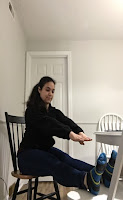Many Americans recently saw a change in their daily work routine. With
the current stay-at-home advisory extended, many of us are working or attending
school from home. In a previous blog, we talked about how prolonged sitting can
have negative short-term and long-term effects on the body. We went over
sitting posture at a desk, muscle groups affected by sitting, and the American
College of Sports Medicine’s recommended activity levels. If you have not read
it, go check it out!
In today’s blog post, we will go over a few stretches that
you can do to combat the short-term effects of sitting. Stretches should be
done every 1-2 hours.
Standing Back Extension
Stand with your feet about hip-width apart, place hands on your hips. Bend
backwards slightly. Return to starting position. Repeat this 10 times. This
exercise is not for you if you have spondylolisthesis, spondylosis, or nerve
pain/leg pain that worsens with each repetition.
Burdenko Sitting and Head Turning (Modified)
Begin sitting on stable chair. Place your hands behind your head,
elbows are up and turned out. Simultaneously stretch your arms out to the sides
as you turn and look to the right. Return to starting position. Repeat on the
left side. Repeat this 10 times on each side. Be careful if you have any
shoulder limitations/injuries, or neck limitations.
Burdenko Bench On/Off Stretch
Start sitting upright in a chair, facing a second chair. Lift one leg
up onto the chair in front of you and reach for it with the opposite hand.
Return to starting position. Repeat on the other leg. Return to starting
position. If you can, lift both legs up simultaneously (back should be
neutral), and reach for your feet with both hands. Repeat 5-10 times each side.
This will stretch your hamstrings. If you have a preferred hamstring stretch,
go ahead and do that instead.
Seated Hip Flexor Stretch
Sit with half your buttocks on the chair, support your self with your
arm. Stretch the leg that is “hanging” off the edge back until you feel a light
stretch along the front of your hip. Hold for 20 seconds. Repeat 3 times on
each side.
Interested in more exercises related to posture? Check out this blog
post: https://mashpeefitness.blogspot.com/2015/03/5-quick-exercises-to-help-correct-poor.html
Blog
post by Damaris Marques PT DPT.
About Damaris
Marques PT DPT
Damaris
("Dee") joined Cape Cod Rehab in August 2017 after receiving both her
Doctor of Physical Therapy and Bachelor of Science from Springfield College.
She is certified in Part I and Part II of the Burdenko Method and believes in a
patient-therapist partnership where both are working together to meet the
patient's functional goals. Dee is bilingual (English and Brazilian Portuguese)
and lists crocheting as a hobby along with singing and a little dancing when no
one is looking!












